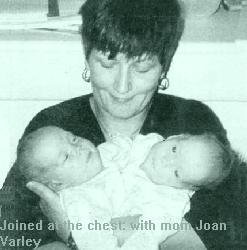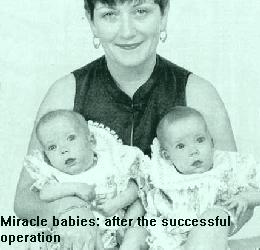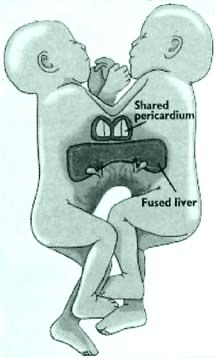

![]()
BRITAIN’S Siamese twins Aoife and Nihamh McDonnell were born kissing each other. Their perfect, miracle expressions of sisterly love proving that the little mites weren’t just linked at the chest.... they are forever joined in heart and soul.


Speaking
for the first time about the extraordinary birth that held Britain enthralled,
elated mum Joan Varley said:
"I burst into tears at the first sight of the babies."
The girls are the first Siamese twins in Britain to both survive an operation to separate them.
But at that first moment together in the delivery room at St. Mary’s Hospital in Manchester, Joan’s worries were consumed by love.
"It was the most incredible first sight a mother could wish for and I wept," she said. "It was truly awesome. Then their arms entwined as they continued to kiss.
"It looked as if they were hugging each other. They were totally gorgeous.
"I wanted to hold them but they were too delicate and I was in no state to cuddle them."
Through tears of joy, 31 year old Joan managed just two words to the daughters who would make medical history. Two words that released the emotion of a pregnancy fraught with hope... then fear.
Gazing at the bundle of life in the nurse’s arms she whispered: "Hello sweethearts."
Explaining their names, Irish-born Joan, who now lives in Manchester, said: "Aoife pronounced Eefa) means Eve in Gaelic. Niamh (pronounced Neave) means Saint."
Joan added: "I’d been terrified of what they might look like. You can’t really tell from the scans.
"But when I saw them they were just perfect baby girls who looked as if they have been stuck together."
Joan had first suspected she was pregnant when friends on a night out remarked that her sparkling blue eyes had changed colour to green.
The tests were positive. Further examination proved she must have conceived two weeks earlier.
Thirteen weeks later, Joan had her first routine scan at St. Mary’s. Husband Paul went with her.
By now it was November and they discovered she was expecting twins.
Joan remembers every second. "I was lying on the bed looking at the screen," she said. "I saw two little heads and I knew they were special.
"Then I looked at the radiographer and I panicked. She looked so concerned. There was something wrong. She looked me in the eye and said, ‘I have to speak to the doctor. I think they are joined.’ Then she left the room."
Joan broke down in tears, hugging Paul for comfort. "I was praying she’d come back and tell me she’d made a mistake," she shuddered.
It was not to be.
Radiologist Dr. Sylvia Rimmer returned and told them she suspected the babies were joined at the liver.
Joan and Paul were then introduced to Dr. Alan Dickson, a consultant paediatric surgeon. He was already able to establish that each child had two arms and two legs.
Joan said: "The doctors told us they would be totally supportive if we opted for a termination.
"Paul and I went outside to be alone, but decided immediately that an abortion was out of the question unless they were damaged in some other way by Down’s Syndrome or spina bifida.
"They were much loved and wanted babies from the start. We had to give them every chance of life."
Doctors performed further tests on the babies by draining fluid from Joan’s womb.
Then there was a devastating two weeks wait before doctors could tell them that their Siamese twins were otherwise perfectly healthy. "I cried all the way home," said Joan. "I had a million unanswered questions in my head - I didn’t understand the bombshell that had been dropped on me."
She had a scan every three weeks. " I kept asking what they looked like," she smiled. "I wanted to know more and more detail, as much as possible.
"I couldn’t read the scan very well, so one of the team drew me a little sketch of what they were like.
"They were facing each other and one was higher than the other and at an angle. The doctors told me they had two separate hearts, two sets of lungs, but were joined at the sternum or breast bone, we also learned the two hearts shared the same sac.
"Their two livers were fused together but separate all the same. But they had one belly button.
"There was one umbilical cord which divided into each of them.
"At this point, they were unsure if they shared the same intestines. I was still very down, but the more the doctors saw, the more they became confident. This gave me hope.
Doctors planned to carry out a Caesarian section on Tuesday, April 8. It would be the 37th week of Joan’s pregnancy.
Joan’s beautiful babies were finally delivered at 4.58 am.
Together they weighed in at a hefty 10 lbs 2 oz.
"I couldn’t see them, but I heard them both scream," she smiled.
‘ I knew this meant that they had both drawn breath and that they were both alive.
But doctors had whisked the twins away to ensure their lives were not in danger.
 Joan had to wait an agonising five minutes before that first glimpse.
Joan had to wait an agonising five minutes before that first glimpse.
"I’d expected them to be all wrinkled," she said, "but in fact their skin was so clean and perfect."
"It was impossible for me to see anything wrong with them. I thought my heart was going to explode with joy."
For 11 weeks before the children were separated Joan and partner Paul discovered that living with Siamese twins was no easy task... just a joyous one. "The first time I held them was wonderful," she said. "A nurse put a pillow on my knee and lay them down in front of me so I could kiss them both.
"Breast feeding was an impossibility because of the angle of the babies’ heads," Joan explained. "At first they had tubes in their noses which were fed with Cow & Gate premium milk.
"This lasted about two weeks and then they started bottle feeding. If both of them were awake I needed help to feed them at the same time - I was bottle feeding one of the girls while the nurse fed the other as I held them both.
"Sometimes I’d feed one of the girls while the other was asleep then swap over.
"Every two hours we had to turn them so one took the weight off the other," said Joan. "We couldn’t lay them on their backs because of the angle at which they were joined.
"They’d sleep with their arms entwined as if they were supporting one another."
And if Niamh woke up before Aoife, added Joan, she could kick her leg and stretch her arms without even waking her sister. After a week Joan and Paul joined with pals to celebrate their babies’ birth.
But only nine close family and friends knew the real truth about the twins. "We were advised by the hospital not to tell everyone to avoid any additional pressure," said Joan.
"They may have been different but we were not ashamed of them. We were desperate to show off our babies but not before they had been safely separated."
The operation was performed by two medical teams led by paediatric professor Lewis Spitz and surgeon Edward Kiley.
"Professor Spitz spoke of the operation with such ease it sounded as simple as baking a cake," said Joan.
"Even though he had to spell out the risk, he said he was very hopeful." In the run-up to the op doctors inserted a sausage-shaped wedge made of soft foam between the twins.
"This was to help to stretch the skin between them," Joan explained.
"That would give the teams enough spare skin to cover the babies’ wounds when they were separated. Nurses had to change the sausage every day and as time went by they used a larger wedge to stretch the skin further.
"They were so young their skin couldn’t have been more supple."
The stage was set for a leap into the unknown. Such an operation had never succeeded in Britain. Either twin - or both - could die.
The brilliant 16-strong team of doctors who separated Aoife and Niamh was led by Professor Lewis Spitz and Edward Kiely, consultant paediatric surgeon.
Niamh and Aoife had been transferred to them at London’s Great Ormond Street hospital for the op.
Prof. Spitz was hopeful because the only organ the twins shared was the liver, which is capable of re- growth. This meant the two halves could grow back to full size.
In an incredible procedure surgeons drained the liver of blood then used an ultrasonic cutter to divide it. Then they sealed the tiny blood vessels with a natural-based glue. During the operation very little blood was lost. The twins also shared the pericardial sac - a membrane surrounding the heart and major blood vessels. The team overcame that problem by reconstructing the original sac for one twin and making an artificial version for the second. Prof. Spitz said modestly: "The twins are very good now.
They’ll be seen regularly by their local hospital and I expect to see them every three months or so."
Continue to Plus page 6 - Educating the misses of Visakha : Goolbai Gunesekera's Chosen Ground
Return to the Plus contents page
![]()
| HOME PAGE | FRONT PAGE | EDITORIAL/OPINION | NEWS / COMMENT | BUSINESS
Please send your comments and suggestions on this web site to
info@suntimes.is.lk or to
webmaster@infolabs.is.lk